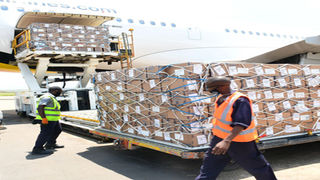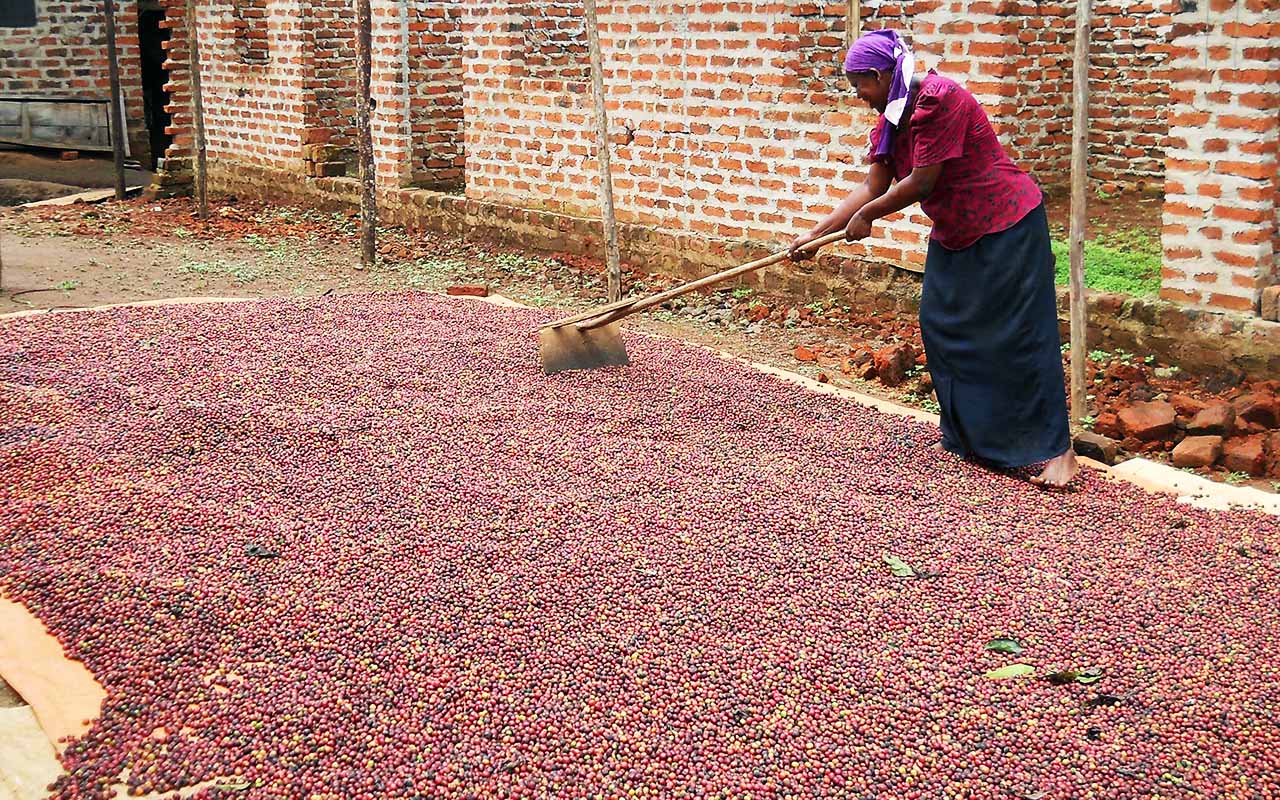
A cargo handler pushes a baggage cart at Entebbe International Airport. PHOTO/STEPHEN OTAGE
|EU-Kenya deal paints gloomy picture for EAC trade ties
What you need to know:
Due to Kenya’s economic partnership agreement with the EU, it will be difficult for Uganda to differentiate similar goods coming from Kenya from those manufactured in the EU.
The Economic Partnership Agreement (EPAs), a pact that is looking to flung open the Least Developed Countries (LDCs) market for the European Union (EU) countries manufactured goods, has started disintegrating the East African Community (EAC) bloc silently, Prosper Magazine can reveal.
On paper, the EPAs are reciprocal Free Trade Agreements (FTAs) between EU and Africa Caribbean Pacific (ACP) states launched in 2002.

Kenyan Trade Minister Moses Kuria (left) and European Union (EU) Trade Commissioner Valdis Dombrovskis (right) sign documents after concluding a trade deal on June 19, 2023. This trade deal will negatively impact regional trade due to violation of the Common External Tariff. PHOTO / COURTESY
Economic partnerships
According to the agreement, the EAC has offered to liberalise 82.6 per cent of her imports from the EU over a 25-year transition period by initially liberalising 65.4 per cent on entry into force of the agreement.
An expert analysis of the agreement in a paper titled: ‘The inherent dangers for the EAC signing the EAC-EU EPA,’ reveals that this liberalisation is taking a static approach to development, considering that it does not envisage Uganda and the East African region as whole graduating to producing either industrial inputs or capital goods – which is absurd.
Further, this deal, being pushed by the European Union (EU) goes against the stated objective of EPAs that speaks to promoting regional integration.
For example in 2007, the EAC countries then, namely: Burundi, Kenya, Rwanda, Tanzania, and Uganda decided to reconfigure and negotiate the EPA as a bloc to strengthen the regional integration agenda. But according to economic and policy analysts, trade and investment treaty negotiators interviewed for this article, the EU is pursuing a fragmented trade policy in the shape and form of EPAs which is essentially a Free Trade Agreement with countries or even blocs (such as EAC) whose capacity to meet the requirement of the deal is largely wanting.
Despite the stated objectives of the EPAs which includes ensuring sustainable development of ACP countries, ensure smooth and gradual integration of ACP countries into the global economy and eradicating poverty, the actual purpose of the EPAs, according to the retired diplomat and veteran trade treaty negotiator, Amb. Nathan Irumba, is to create a free trade area between two economically unequal regions – Africa and Europe.
Tread cautiously
On June 9th, 2023, the EU and Kenya announced the political conclusion of the negotiations for an Economic Partnership Agreement. The Agreement will undergo legal scrubbing and translation before signature and conclusion by the EU Council, upon which the EU and Kenya can sign and ratify.
This has since renewed debate on whether the EPA, which the EU has been relentlessly pushing as its cardinal trade policy instrument, is the right tool to shape the Afro-Euro relationship.
In the course of this Prosper Magazine special project, another question that kept popping up from those who are critical of EU Free Trade Agreements is the potential implication of the EU-Kenya EPA on other EAC Partner States such as Uganda who until lately seemed to have been in favour of the bloc consensus as opposed to individual member state negotiations.
According to researcher Africa Kiiza, who is also a PhD Fellow, Faculty of Business, Economics and Social Sciences; Universität Hamburg, the Kenya-EU EPA has created confusion regarding the direction that EAC Partner States should now tow.
“Under Article 144, the Kenya-EU, EPA shall be open to accession by any other EAC Partner State, provided they show intent by submitting a request for accession to the EPA Council,” reveals researcher Kiiza, who is also a trade and investment treaty analyst.
The PhD Fellow further recalled that the stalled EAC-EU EPA negotiations were concluded in 2014, signed by Rwanda and Kenya in 2016, with the latter ratifying it in the same year.
“A key question that is yet to be answered is whether, by providing for an option of accession by other EAC Partner States to the Kenya -EU EPA, the one originally negotiated with the EAC will be abandoned,” he rhetorically asked, before, noting, “nevertheless, whether Uganda accedes to the Kenya-EU EPA or signs and ratifies the stalled EU-EAC EPA, it does not take away the fact that either version of the EPA has a number of far-reaching implications for Uganda’s development.”
Dire consequences
One of the immediate implications of the EPA on Uganda’s economy will be the loss of revenue due to the high level of liberalisation. The United Nations Economic Commission for Africa (UNECA) in its report, warned that for Uganda, the EPA would result in revenue shortfalls estimated at $ 9.4million (Shs34.3 billion) annually once the country’s market opens up to the tune of 82.6 per cent to goods from the EU. This revenue loss, which is slightly more than two financial year budgets for Uganda National Bureau of Standards (UNBS), is deemed as a conservative estimate.

A woman packages exports. While the EU commits not to grant export subsidies to all agricultural exports to State Parties to the EPA, the real challenge to Uganda’s agricultural production and industrialisation is the ever-increasing domestic subsidies in the EU. PHOTO/MICHAEL KAKUMIRIZI
“For a country which is heavily indebted with her debt to GDP [Gross Domestic Product] ratio hovering at 52 per cent—a dangerous path to tread, and continues to rely on aid, this revenue shortfall would have serious implications on the country’s ability to mobilise resources for its development,” said the PhD Fellow, Universität Hamburg, in his analysis of the agreement.
He continued: “This liberalisation risks putting local industries in jeopardy. For example, since 2021, Uganda, like other EAC countries, has become a frontier market for milk exports from the EU, which poses a threat to the country.”
While the EU commits not to grant export subsidies to all agricultural exports to State Parties to the EPA, the real challenge to Uganda’s agricultural production and industrialisation is the ever-increasing domestic subsidies in the EU, which issue, the EU has declined to discuss both in the EPA and World Trade Organisation (WTO).
Like Ms Faith Lumonya, a development economist and policy advocacy expert, researcher Kiiza, believes the EPA will also undermine the South-South relationship by circumscribing Uganda’s external trade relations as the Most Favoured Nation (MFN) provision of the EPA require her to extend to the EU any favourable treatment resulting from a preferential trade agreement with a major trading economy/country. This could undermine Uganda’s efforts in her economic pursuits with other countries across the globe.
“Should Kenya go ahead to unilaterally ratify and implement the EPA, it will negatively impact regional trade due to violation of the Common External Tariff,” Mr Kiiza stressed in an interview with Prosper magazine last week.
“This is because it will be difficult for Uganda to differentiate similar goods coming from Kenya from those manufactured in the EU. This may result in trade tensions between the countries and ultimately antagonise trade between the countries.
“For Uganda, this will be a big blow given that 86 per cent of her exports are destined for Africa as emphasized by President Museveni in his State of the Nation address last month. Moreover, the EPA is broader in scope and targets areas like Investment, Competition Policy and World Trade Organisation (WTO) plus Intellectual Property Rights which were rejected within the context of the WTO, and will circumscribe the much-needed development policy space,” he concluded.
Private sector
Private sector players are closely looking to see how government will move after Kenya played her cards.
For Ms Dorothy Kimuli, a budding entrepreneur, government should beware of the economic stage Uganda is at to avoid going into a ring with a “heavy weight boxing champion” when you are not at the same level.
“Our businesses are at different levels of growth and development. So don’t commit us into a competition that will either swallow or cripple our growth,” Ms Kimuli who adds value to chilli told Prosper Magazine.
She continued: “We still need to develop our standards and enssure that they will be accepted wherever we take them. We have to grow our production and value chain. We need to improve our packaging and brands. Unless we do that, it will be difficult to compete,” Ms Kimuli said.
The EPA is also highly skewed in favour of the EU. This is why most treaty analysts and negotiators, CSOs and private sector players spoken to believe there is an urgent need to rethink the EPA to make it mutually beneficial while addressing the longstanding challenges inhibiting Uganda’s quest for aspirations for structural transformation. Structural transformation, rather than structural adjustment in Uganda is critical for promoting industrialisation for decent jobs, value addition, increasing the continent’s trade share and developing regional value chains.
But the current EPA cannot deliver.
EU’s dream, President Museveni value
Upon his appointment, late last year Ambassador and head of the European Union Delegation to Uganda, Jan Sadek, didn’t waste time urging Uganda to sign the EPAs and have it out of the way. Speaking during the Uganda – EU Business Forum, 2022, he told President Museveni that EPAs is still on the agenda and hasn’t been signed yet – urging the President to see to it that it concluded. He was of the view that the agreement will mark a new milestone in the economic relations between Uganda and Europe.
He said: “I have been pleased to learn about the Ugandan interest in signing the economic partnership agreement with the European Union which would guarantee immediate duty-free and quota free access to the EU market for all exports. And the European Union Market is a very lucrative market of 500 million inhabitants.”
In response, President Museveni during second edition of the Uganda - EU business forum, said: “I am very glad to hear the Ambassador asking us to sign. We had some internal issues among ourselves, but we value that market access to EU…”




